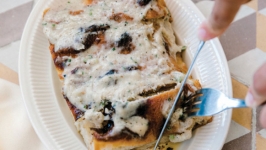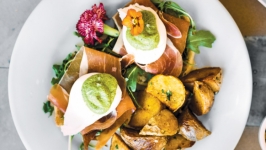Sushi Hayashi
We all go out to eat for different reasons. We eat to sustain ourselves; we eat for comfort; at times, we’re just curious. Sushi Hayashi opened in 2006 and served as a bridge between Oklahoma City’s curious eaters and the West Coast approach to preparing medium grain white rice and raw seafood. Later, it served as my own comforting link to the flavors of my childhood.
I’ve lived in several places. My parents were born in South Korea and I was born in Norman. In elementary school, my family moved to Seoul, South Korea, for three years, then back to Oklahoma. We next moved to the Pacific Northwest, this time for months instead of years, then back to Oklahoma. This was all before I finished middle school. I excelled at math and sports, and I could talk a good game. But, between the national, cultural, and school transitions, reading and writing proved difficult. I struggled to determine what post-high school life held and was frustrated by my mother’s hopes to claim a doctor or lawyer son. To give lip service to her projected college ambitions, I enrolled in the William F. Harrah College of Hospitality at the University of Nevada, Las Vegas. It was the best hospitality school, a superlative my mother appreciated, and it defined my life in two ways. First, I was immediately thrown into the world of food service. To help pay for school I applied for a dishwasher position at a restaurant called Sushi Wa, but, shocking me more than anyone else, they told me I looked more like a chef. I loved working with my hands as a kid, disassembling and reassembling toys and everything else. The fine motor control I unintentionally practiced as a child transferred smoothly to the fine movements required for sushi preparation and Japanese food generally. Between school and work, I moved from working the line at age 18 to being the executive chef at Mizuya at the Mandalay Bay resort three years later. The food at Mizuya reminded me of the flavors and textures I found in Seoul and the Pacific Northwest. It reminded me of home, and tied me closer to my Korean heritage. It was there I discovered that my sense memory for food operates like a Rolodex. I can still taste every impactful meal I’ve had and recreate a reasonably accurate copy on the spot. Some chefs create like artists on a clean canvas, but I stitch together the comfort of my memories.
“The meal savors the natural flavors and textures of the ingredients — in stark contrast to my time in fast-paced and showy Las Vegas kitchens. I had spent so long cooking for curious people who wanted to be entertained by the novelty of new flavors, textures, and presentation that I realized I yearned for a mixture of comfort and simplicity.”
Second, Las Vegas allowed me to surround myself with fun, but fundamentally irresponsible people: wealthy, carefree children of exceptionally wealthy families. My family wasn’t wealthy. We always knew where our next meal was coming from, but at age 12 I was expected to be the “man of the family” when we returned to Oklahoma and my father had to stay and work in South Korea. It meant I saw myself as a leader in childhood, which later helped in the commercial kitchen. It also meant I always felt like I was falling short financially. What do you do when you’re a young man and want to get rich quick and live like your uber-wealthy friends? Gamble. Many paychecks were blown in casinos, or bets and side-bets among kitchen staff. I had learned invaluable skills, but if I stayed in Las Vegas much longer my future wouldn’t be worth thinking about. It was 2009 and my family was relaying to me how much OKC had grown and how I needed to get my head on straight.
Returning home was an adjustment. Sushi Hayashi was one of the very few restaurants where I could find the ideal combination of my childhood flavors and the styles of sushi I’d grown accustomed to making in Las Vegas and eating on trips farther west. My favorite meal? The Omakase, or chef’s tasting menu, with its nigiri and sashimi. My favorites started with the leaner, white fish with its fresh, crunchier texture that immediately begins to melt in your mouth. After an interlude of egg custard, the meal moved to heavier, fat-tier salmon, yellowtail, and seabass, which impart a softer, buttery mouthfeel. Finally, the creamier, sweeter ocean candy: sea urchin and freshwater eel. The meal savors the natural flavors and textures of the ingredients — in stark contrast to my time in fast-paced and showy Las Vegas kitchens. I had spent so long cooking for curious people who wanted to be entertained by the novelty of new flavors, textures, and presentation that I realized I yearned for a mixture of comfort and simplicity.
Sushi Hayashi’s Google reviews reveal a pattern within their alternating 1 to 5 stars. The husband, Jin Kim, has been preparing sushi for 30 years and imports seafood directly from California. It’s not cheap, but it’s delicious. There are two seatings, lunch (11 a.m.-2 p.m.) and dinner (5-8 p.m.). Evenings are often by reservations only and Jin’s wife, who runs front-of-house, prefers a quiet and peaceful restaurant and may not seat walk-ins if it will increase sound levels or disrupt what she believes is the ideal flow. At times, she is curt. Sometimes very curt. The rub occurs when a customer expects a delicious meal, but is thwarted by exacting and unmoving hospitality practices. It’s a crucible that creates a pressure only internet review sites can fully release.
As diners, we are most familiar with a near exclusive customer-centric mindset that arranges as few steps as possible between a customer and their food, and a business and the customer’s wallet. I know because I’ve run restaurants and currently own a Korean-style fried chicken concept, Birdie’s, in Edmond. Depending on an individual customer’s expectation, subverting or operating outside that customer-is-always-right approach ensures either intense dedication or ire, challenging the strict roles underpinning the modern hospitality industry. However, patrons comfortable living by someone else’s rules, even when seemingly arbitrary, are treated to what many reviewers regularly call the best sushi in Oklahoma City.
Las Vegas life and work created the foundation for my appreciation for both Sushi Hayashi and the creation of Birdie’s. We’re not driven by one thing. If we take off our blinders and exist in a give and take between expectations and reality, we find that creativity and a little flexibility can help us find a great meal. Through curiosity, we can find comfort and be sustained.
> Sushi Hayashi, 10600 S. Penn Ave., OKC, (405) 759-7788







